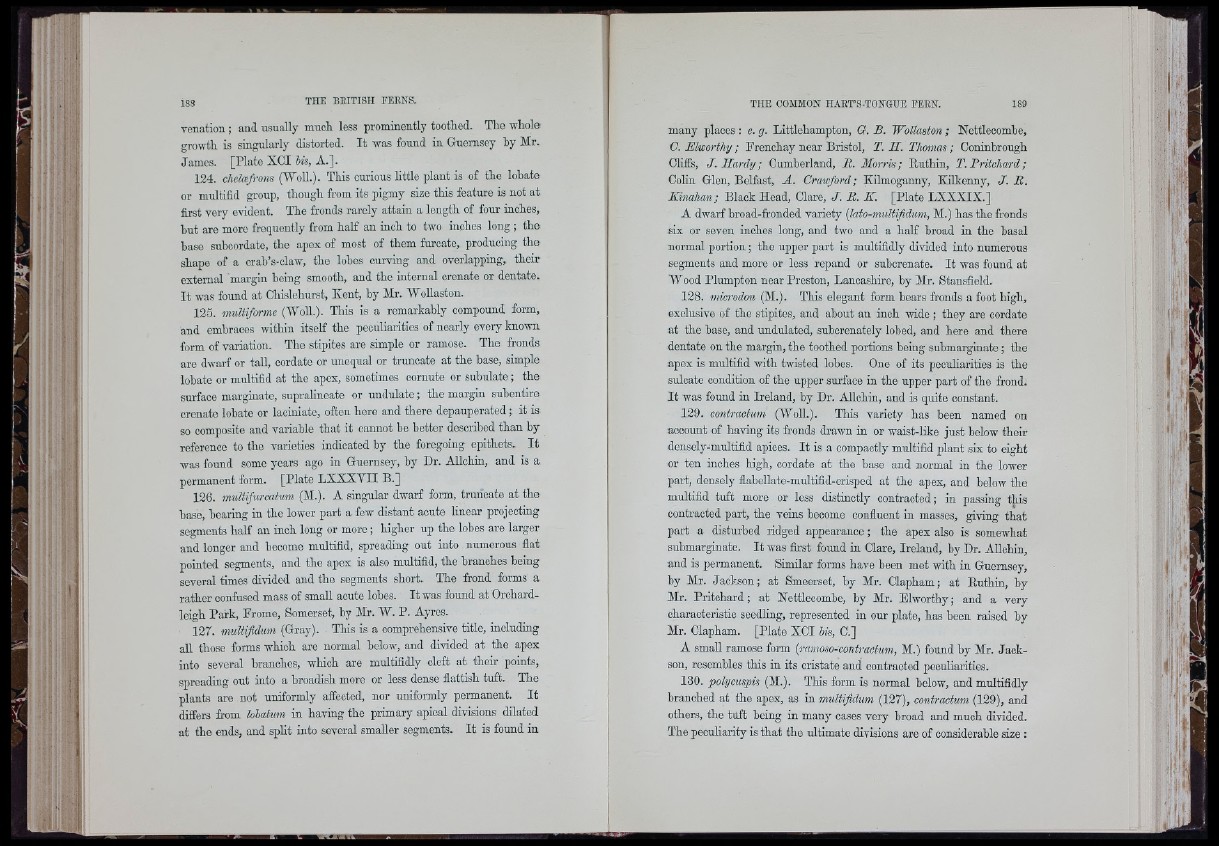
venation ; and usually muoli less prominently toothed. The whole
growth is singularly distorted. It was found in Guernsey by Mr.
James. [Plate XGI bis, A.].
124. chelcefrons (AVoU.). This curious little plant is of the lobato
or multifid group, though from its pigmy size this feature is not at
first very evident. The fronds rarely attain a length of four inches,
hut are moro frequently from half an inch to two inches long ; the
base subcordate, tho apex of most of them furcate, producing tho
shape of a crah’s-claw, tho lobes curving and overlapping, their
external margin heing smooth, and the internal crenate or dentate.
It was found at Chislehurst, Kent, by Mr. AVollaston.
125. multiforme (AVoll.). This is a remarkably compound form,
and embraces within itself tho peculiarities of nearly every known
form of variation. The stipites are simple or ramose. The fronds
are dwarf or tail, cordate or unequal or truncate at the base, simple
lohate or multifid at the apex, sometimes cornute or subulate; the
surface marginate, supralineate or undulate; the margin suhentire
crenate lobate or laciniate, often here and there depauperated; it is
so composite and variable that it cannot be hotter described than by
reference to the varieties indicated by the foregoing epithets. It
was found some years ago in Guernsey, by Dr. Allchin, and is a
permanent form. [Plate LXXXVII B.]
126. multifurcatum (AL). A singular dwarf form, truncate at the
base, hearing in the lower part a few distant acute linear projecting
segments half an inch long or moro ; higher up the lobos are larger
and longer and become multifid, spreading out into numerous flat
pointed segments, and the apex is also multifid, the branches being
several times divided and the segments short. The frond forms a
rather confused mass of small acute lobes. It was found at Orohard-
leigh Park, Frome, Somerset, by Air. AV. P. Ayres.
127. multifidum (Gray). This is a comprehensive title, including
all those forms which are normal below, and divided at the apex
into several branches, which are multifidly cleft at thoir points,
spreading ont into a broadish more or less dense flattish tuft. The
plants are not uniformly aflfected, nor uniformly permanent. It
differs from lobatum in having the primary apical divisions dilated
at the ends, and split into several smaUer segments. It is found in
many places : e. g. Littlehampton, G. B. Wollaston ; Nettlecombe,
G. Elworthy; Frenchay near Bristol, T. H. Thomas; Coninbrough
Cliffs, J. Hardy; Cumberland, B. Morris; Buthin, T. Pritchard ;
Colin Glen, Belfast, A . Crawford; Kilmoganny, Kilkenny, J. B.
Kinahan; Black Head, Clare, J. B. K . [Plate LXXXIX.]
A dwarf hroad-fronded variety {lato-multifidum, M.) has the fronds
six or seven inches long, and two and a half broad in the basal
normal portion; the upper part is multifidly divided into numerous
segments and more or less repand or suborenate. It was found at
AVood Plumpton near Preston, Lancashire, by Air. Stansfield.
128. microdon (M.). This elegant form hears fronds a foot high,
exclusive of tho stipites, and about an inch wide; they are cordate
at the base, and undulated, subcrenately lobed, and here and there
dentate on the margin, the toothed portions being suhmarginate; the
apex is multifid with twisted lobes. One of its peculiarities is the
suloate condition of the upper surface in the upper part of the frond.
I t was found in Ireland, by Dr. Allchin, and is quite constant.
129. contractum (AVoll.). This variety has been named on
account of having its fronds drawn in or waist-like just below thoir
donsely-multifid apices. It is a compactly multifid plant six to eight
or ten inches high, cordate at the base and normal in the lower
part, densely flabcUate-multifid-crisped at the apex, and below the
multifid tuft more or less distinctly contracted; in passing this
contracted part, the veins become confluent in masses, giving that
part a disturbed ridged appearance ; the apex also is somewhat
suhmarginate. It was first found in Clare, Ireland, by Dr. Allchin,
and is permanent. Similar forms have been met with in Guernsey,
by Mr. Jackson; at Smeerset, by Air. Clapham; at Ruthin, by
Mr. Pritchard; at Nettlecombe, by Air. Elworthy; and a very
characteristic seedling, represented in our plate, has been raised by
Air. Clapham. [Plate XCI bis, C.]
A small ramose form {ramoso-contractum, M.) found by Mr. Jackson,
resembles this in its cristate and contracted peculiarities.
130. polycuspis (M.). This form is normal below, and multifidly
branched at the apex, as in multifidum (127), contractum (129), and
others, the tuft being in many cases very broad and much divided.
The peculiarity is that the ultimate divisions are of considerable size :
li’i'
1
>■ !l
(ki
t i :
1
III-
(j
It
lit